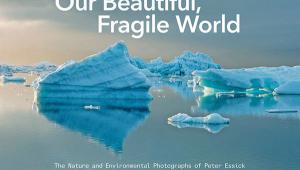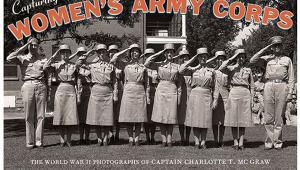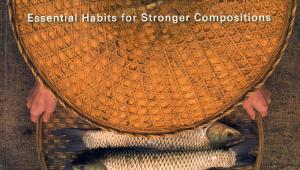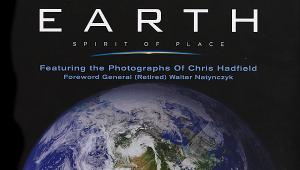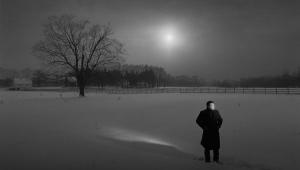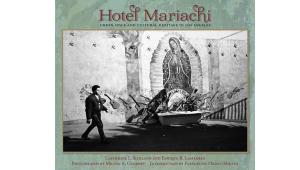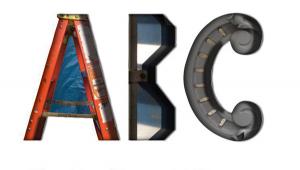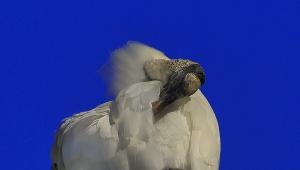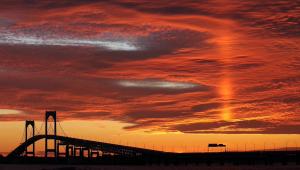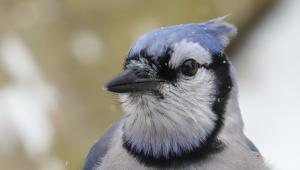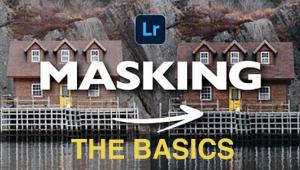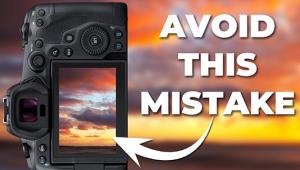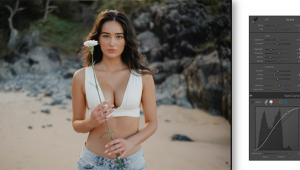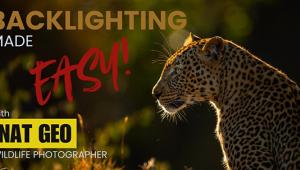Top Digital Imaging Books Of 2008; This Year’s Digital All-Stars
“Believe nothing, no matter where you read it, or who said it, no matter if I have said it, unless it agrees with your own reason and your own common sense.”
—The Buddha
Italian publisher FMR recently produced an art book called Michelangelo: La Dotta Mano which, I believe, translates into “You ‘da Man, Mike” or “The Wise Hand” for picky readers. The book is a tribute to Michelangelo through images of his sculptures made by photographer Aurelio Amendola. Only 99 of these limited editions are being offered at $150,000 each. The book’s cover is hand carved of marble from the same quarry used by Michelangelo and rests on a matching easel. Helmut Newton’s Sumo is another big coffee-table book full of photos of nude people—not just naked statues—and, like Cosmo Kramer’s book, came with its own coffee table. When released in 2000 Sumo sold for $12,500 and was limited to 10,000 copies, but I’ve seen copies on sale recently as low as $2500. You’re in luck because I’m gonna introduce you to lots of great books from people who may not be as famous as the late Mr. Newton but whose work will help with your own photographic efforts and may inspire you just as much.
The Crème De La CrèmeDigital Photography Masterclass; by Tom Ang; DK Publishing; 360 pages; $50 (ISBN: 978-0-7566-3672-2)
This is the digital photography equivalent of War and Peace, and while Tom Ang may be more Grisham than Tolstoy, it’s a great read. Digital Photography Masterclass is the perfect storm of publishing, combining lush photography, topnotch design and production values, with tutorials that make sense. The book eschews the visual and verbal clichés that flood UK-published books and achieves a worldview featuring real-life subject matter and interviews with other photographers, including opinions other than Ang’s. End-of-chapter assignments are presented along with tips and references to what Ang calls “Must-See Masters,” providing historical perspective for a particular genre, something lacking in many of today’s photographic books. As they say on TV, “you would expect to pay” $100 or more for this book, but it sells for less than $40 online. Did I mention it’s hardbound?
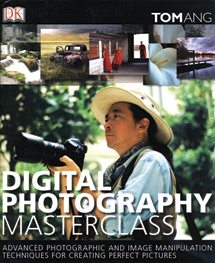 |
The Moment It Clicks; by Joe McNally; New Riders Press; 272 pages; $54.99 (ISBN: 978-0-3215-4408-7)
While pricey, Joe McNally’s book is the in-print version of a ride-along as he combines pithy advice for improving your photography with you-are-there commentary on a body of work that even includes a dead body on a subway platform photographed in gritty black and white. The image is not as gruesome as it sounds and contains echoes of images made by the late Weegee née Arthur Fellig. Balancing the occasional grim or poignant photos you’ll find others celebrating humanity’s joyous side. Hardware geeks will enjoy chapters such as “Joe’s Grip and Lighting Gear,” but there’s more. Combining elements of a how-to book and written in a more conversational tone than the typical “do it my way or else” approach with that of a coffee-table book, The Moment It Clicks is neither. Instead it’s the perfect hybrid that informs and inspires.
 |
Advanced Digital Black & White Photography; by John Beardsworth; Lark Books; 192 pages; $24.95 (ISBN: 978-1-6005-9210-2)
This is the best produced how-to book of the year merging outstanding design, concise writing, and on-target illustrations at a more-than-fair price. The examples used, which in far too many photo books are mediocre and included only to fit the text, are superb and not only illustrate the author’s points but encourage the reader to reach for those same heights with their own photography. Topics range from the mundane creation of the digital version of test strips to handcoloring using a Smart car as a subject to having printed output match what you see on the screen. This is a must-have book for anyone interested in digital monochrome imagery.
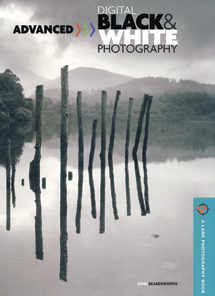 |
Exposure Photo Workshop; by Jeff Wignall; Wiley; 299 pages; $29.99 (ISBN: 978-0-470-11435-3)
This is another volume in Wiley’s Photo Workshop series and is the best of the bunch and may be the best book yet written about exposure. Nothing is more critical in capturing the image than getting the exposure right and Jeff Wignall has the photographic and writing chops to show readers how to capture perfectly exposed photographs. In these well-illustrated pages, he shows you how to deal with difficult existing light conditions, challenging weather, and even flash, including a section on using wireless multiple flash units that explains and never confuses. Each chapter ends with an assignment and you can upload your own images to a website to get input from others about how well you succeeded. It doesn’t get more interactive than that!
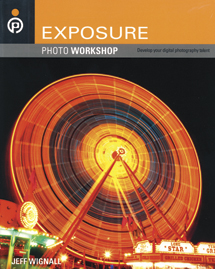 |
Getting Started
David Busch’s Quick Snap Guide to Using Digital SLR Lenses; by David Busch; Thomson Course Technology; 170 pages; $29.99 (ISBN: 1-59863-455-0)
Written by Thomson’s go-to digital guy and produced in a refreshingly designed landscape package, this book isn’t targeted at specific lenses but is about choosing and using classes of lenses and lens accessories. Wide angle lenses, for example, are covered in six crisply written and beautifully illustrated pages featuring topics such as what a lens can do, how it works, and choosing the right focal length. Along the way, David Busch introduces readers to accessories such as tripods, bellows, and filters that are covered in the same low-fat way with just the well-illustrated facts. While not inexpensive for a small book, it’s ideal for the new D-SLR owner who wants to learn what lenses he or she needs for their forthcoming photographic exploits.
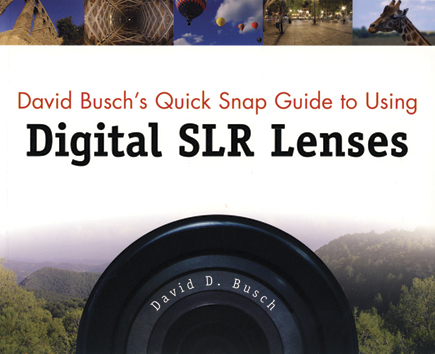 |
Digital SLR Handbook; by John Freeman; Amphoto Books; 256 pages; $19.95 (ISBN: 978-0-8174-0518-2)
Another UK import but one of the good ones, John Freeman’s book is designed to get the SLR newbie up to speed. Assisted by a compact size, excellent writing, and superlative illustrations, Freeman shows the photographer graduating from a point-and-shoot camera how to use their new SLR to shoot landscapes, nature, action, architecture, and people. Nudity Advisory: In the section on people photography and following pages showing apple-cheeked kiddies, you’ll find a section on photographing the nude. The last section of the book is on postproduction and here Freeman provides an excellent introduction to image manipulation, special effects, and making prints. The book is an excellent value for the quality of its production, content, and how much information is crammed into 256 well-designed pages.
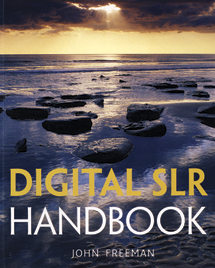 |
A Digital Photographer’s Guide to Model Releases; by Dan Heller; Wiley; 279 pages; $29.99 (ISBN: 978-0-470-22856-2)
While it sounds like a collection of model release forms, what’s inside is an inside look at the legal ramifications and obligations of using model releases and not just for pictures of pretty girls. Often overlooked is that places and buildings also require a release and that some of these same places and buildings are copyrighted and trademarked, as odd as that sounds. Dan Heller uses real-life examples of situations when getting a release is the thing to do and how some venues’ tickets often have a disclaimer that any photos you make cannot be used for commercial purposes. It’s a legal minefield out there and if you intend to sell your photographs this book can prevent you from getting blown up legally and financially.
 |
The Art of Digital Photography; by Joseph Meehan; Lark Books; 192 pages; $24.95 (ISBN: 1-57990-970-1)
This Kodak-branded book is subtitled “Mood, Ambience & Dramatic Effects” and combines topnotch illustrations with Joseph Meehan’s reasoned text. The technical information for creating these spectacular images makes this book the perfect holiday gift for anyone who thinks “there’s nothing left to photograph.” The images and words will inspire newcomers or experienced shooters who’ve let their camera gather dust to get off their barcaloungers and make new images. While a few of the photographs were made in exotic places most of us cannot afford to visit, most are closer to home and easier to capture, making it the best kind of how-to book. Meehan proves that even the most mundane subject matter can take on a whole new look and meaning when photographed under the right lighting conditions.
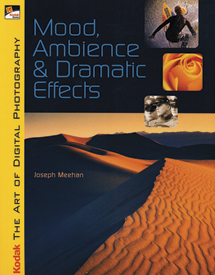 |
The Digital Zone System
The Complete Raw Workflow Guide; by Philip Andrews; Focal Press; 368 pages; $39.95 (ISBN: 978-0-240-81027-0)
There is no doubt that processing raw format image files is the digital equivalent of Ansel Adams’ Zone System. It’s all there. That same blend of technology, hands-on know-how, and mysticism that’s created a cottage industry of books. This year Philip Andrews updated Raw Workflow: From Capture to Archives that I originally co-wrote with him and Yvonne Butler into a bigger, better book that’s the same price as the first edition. The new book is creatively produced, well illustrated, and full of practical insights that Andrews brings to raw processing. The how-to sections are well designed, making the raw conversion process easy to follow and are sure to please the technically inclined reader and the newbie who wants to know what all the fuss is about. Like Godfather II, this is a sequel that’s better than the best-selling original.
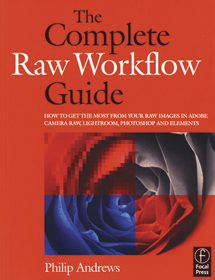 |
Understanding RAW Photography; by Andy Rouse; Photographers’ Institute Press; 144 pages; $24.95 (ISBN: 978-1-86108-515-3)
One of my most treasured Zone System books is Fred Picker’s Zone VI Workshop that distilled this complex topic into a 110 easily digestible pages. Andy Rouse accomplishes this same feat by providing the perfect beginner’s gateway into creating great-looking images from raw format files. Rouse’s approach is built around a suggested workflow beginning with camera setup, followed by editing, correction, and management. The book follows the same structure and while compact, is lushly produced, beautifully designed, and get this—it’s a hardback. With many softbound books selling for $29.95, this is a bargain not just for the useful information but is complemented by Rouse’s own amazing nature photography. If you’re thinking about capturing raw format images, start with this book.
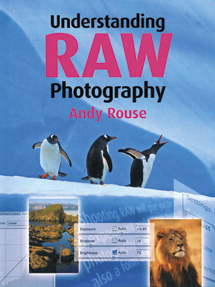 |
Photoshop CS3 RAW; by Mikkel Aaland; O’Reilly; 270 pages; $34.99 (ISBN: 0-596-51052-7)
While it’s a better than average chance Photoshop CS3 will be replaced by the time you read this, I’ve included this book only to show the importance of raw conversion even if the beloved, by many (including myself), Adobe Camera Raw (ACR) software may be different in its next incarnation. Every publisher seems to need a raw book and O’Reilly’s is a great one. The truth is, that like everything else, the next version of ACR will be evolutionary and there’s bound to be a lot of stuff included in this book that will carry over to the next version. That’s because Mikkel Aaland has produced the most intense, most comprehensive investigation of Adobe’s raw processing software anyone has ever done.
 |
RAW Pipeline; by Ted Dillard; Lark Books; 224 pages; $29.95 (ISBN: 1-60059-279-1)
What I liked about this book is the aggressive design using large, easy-to-read screen shots showing the techniques Ted Dillard explains. This makes the process of learning how to control contrast, for example, easier than it might be otherwise. The whole book reeks of high-quality production and that goes for Dillard’s text as well. He assumes nothing and kicks the book off with a useful section called “Preparing the Work Area” that will
kick-start your own raw format explorations. While techie and geeky as any of these other raw books, Dillard makes the process one that encourages the reader every step of the way.
 |
Mastering HDR Photography; by Michael Freeman; Amphoto Books; 160 pages; $24.95 (ISBN: 0-8174-9999-7)
I don’t know if John and Michael Freeman are the Ethan and Joel Coen or the Harry and Lloyd of the photographic book world, but two things are for sure: They are prolific and produce excellent books from a text and photographic point of view. Michael’s book tackles the creation of HDR (High Dynamic Range) images that’s the fuel of the digital Zone System movement and something Ansel Adams would have loved. Since the HDR concept is simple (while execution can be complex), Michael’s book is small but tackles both problems and the solutions. Capturing HDR images with people produces ghosting because the people inevitably move during the multiple exposures required. Michael offers a simple solution using layers and Photoshop’s Eraser tool that may not produce an image that’s 100 percent HDR but produces something approaching it. While there’s the inevitable advice that should be taken with a grain of salt on the author’s preferred HDR tools, it’s kept to a minimum to focus in on workflow and hot topics such as HDR stitching.
 |
Film & Digital Techniques for Zone System Photography; by Dr. Glenn Rand; Amherst Media; 128 pages; $34.95 (ISBN: 978-1-58428-227-3)
Why not just go with the real thing? That’s what Dr. Glenn Rand does in this beautifully illustrated book on getting started with the Zone System, whether shooting film or using digital capture. Precise exposure is the Zone System’s key ingredient and Rand introduces Zone values and placement and since previsualization is an important component of Ansel Adams’ system, his chapter on “Visualizing the System” is especially helpful. The printing section may be less important for those readers looking for applications in the digital realm. Most of the images are monochrome but in Chapter 10 on digital photography, some color images appear along with a precise methodology for applying Zone techniques within a digital workflow. This is one of the best new books on the Zone System to come along in a while combining a succinct approach with dramatic photographs that provide motivation to use it.
 |
Technique
Digital Macro Photography; by Ross Hoddinott; Photographers’ Institute Press; 176 pages; $17.95 (ISBN: 978-1-86108-530-6)
I’ve often criticized British publishers selling books in the U.S.A. but Photographers’ Institute Press is the exception that proves the rule. This is an affordable, well-produced book chock full of useful information wrapped up in an attractive package. There is no filler in these 176 pages; each and every one is full of practical information and well-reproduced images. As you might gather from the cover photograph, there are a lot of insect images and while I personally have an aversion to this kind of photo (“I had bugs for lunch”), you may not. The bug shots are balanced with attractive images of flora, fauna, and manmade objects. While the book occasionally gets too basic—there’s the inevitable “Rule of Thirds” discussion—there is something here for any reader interested in macro photography. With Amazon.com selling it for a little over $12, this is a bargain.
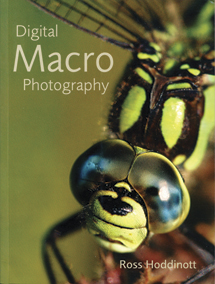 |
Minimalist Lighting; by Kirk Tuck; Amherst Media; 128 pages; $34.95 (ISBN: 978-1-58428-230-3)
Less is more applies to this wonderful book about using not just fewer lights for portraiture but using small shoe-mount flashes to achieve natural-looking results. Making excellent use of Amherst’s 128-page large format design, Tuck guides you through the hardware basics, showing examples made with Nikon and Canon flashes, but also how to use different kinds of ancillary grip equipment that can be the on-location photographer’s secret weapon. There is a section on using small flashes for copy work that most will blow right by but the other sections are pure gold, showing real solutions to real lighting situations and along the way creating some of the most natural-looking on-location portraits I’ve seen.
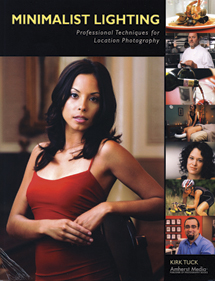 |
- Log in or register to post comments
